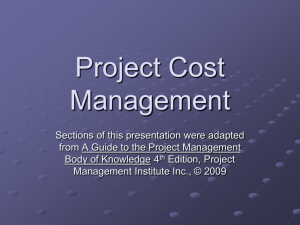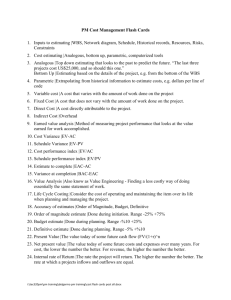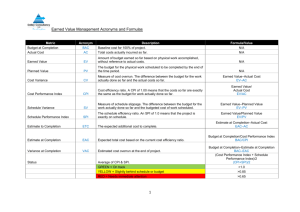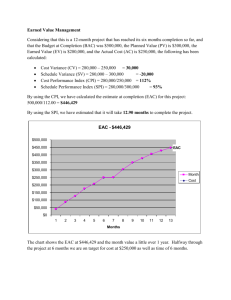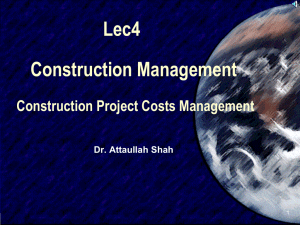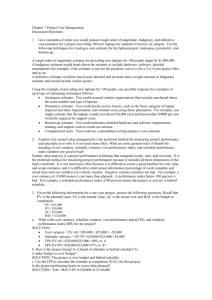Chapter_7_Cost_Management
advertisement
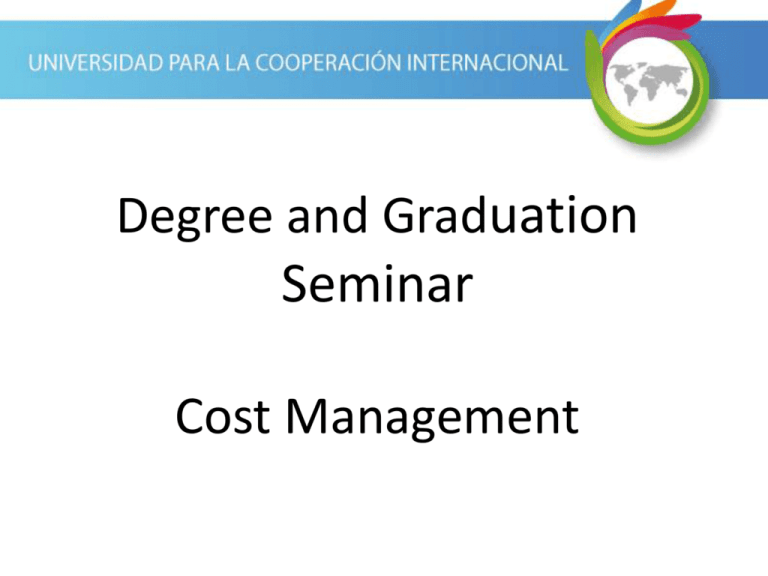
Degree and Graduation Seminar Cost Management Cost Management Process • Cost management is the process of estimating, budgeting, and controlling costs so that the project can be completed within the approved budget. Earned Value Management (EVM) • EVM is a management methodology for integrating scope, schedule, and resources, and for objectively measuring project performance and progress. Planned Value (PV) • Planned Value (PV) is the authorized budget assigned to the scheduled work to be accomplished for a scheduled activity or WBS component. Earned Value (EV) • Earned Value (EV) is the value of work performed expressed in terms of the approved budget assigned to that work for a scheduled activity or WBS component. Actual Cost (AC) • AC refers to the total costs actually incurred and recorded in accomplishing work performed during a given time period for a scheduled activity or WBS component. Cost Performance Index (CPI) • The cost performance index (CPI) is a measure of cost efficiency of a project. It is the ratio of earned value (EV) to actual costs (AC). CPI=EV/AC. Schedule Performance Index (SPI) • The schedule performance index (SPI) is a measure of schedule efficiency of a project. It is the ratio of earned value (EV) to planned value (PV). SPI=EV/PV. Budget At Completion (BAC) • Budget at completion (BAC) is the sum of all budgets established for the work to be performed on a project or a WBS component or a scheduled activity. It represents the total planned value for the project. Estimate At Completion (EAC) • The estimate at completion (EAC) is the expected total cost of a scheduled activity, a WBS component, or the project when the defined scope of work will be completed. Estimate To Complete (ETC) • The estimate to complete (ETC) is the expected cost needed to complete all remaining work for a scheduled activity, WBS component, or project. Variance At Completion (VAC) • The variance at completion (VAC) is the difference between the budget at completion (BAC) and the estimate at completion (EAC). VAC=BAC-EAC. Cost Variance (CV) • Cost variance (CV) is a measure of cost performance of a project. It is the difference between earned value (EV) and actual cost (AC). CV=EV-AC. Schedule Variance (SV) • Schedule variance (SV) is a measure of schedule performance of a project. It is the difference between the earned value (EV) and the planned value (PV). SV=EV-PV. To-complete Cost Performance Index (TCPI) • TCPI is the calculated projection of cost performance that must be achieved on the remaining work to meet a specified management goal, such as the BAC or the EAC. It is the ratio of remaining work to the remaining funds . Cost Baseline • The cost baseline is the expected cost for the project, produced during the cost budgeting process. Cost Budget • Cost budget is the approved estimate for the project or any WBS component or any scheduled activity. Performance Measurement Baseline • Performance measurement baseline is the term used to collectively identify the project plan baseline, schedule baseline and the cost baseline. Three-point Estimating • Three-point estimating is an analytical technique that uses three cost or duration estimates to represent the optimistic, most likely, and pessimistic scenarios. Analogous Estimating • Analogous estimating is an estimating technique that uses the values of parameters, such as scope, cost, budget, and duration, or measures of scale such as size, weight, and complexity, from a previous, similar activity, as the basis for estimating the same parameter or measure for a future activity. Bottom-up Estimating • Bottom-up estimating is a method of estimating a component of work. The work is decomposed into more detail. An estimate of what is needed to meet the requirements of each of the lower, more detailed pieces of work is prepared, and these estimates are then aggregated into a total quantity for the component of work. Parametric Estimating • Parametric estimating is a method that uses a statistical relationship between historical data and other variables to calculate an estimate for activity parameters, such as scope, cost, budget, and duration. Inputs for Estimating Costs • The inputs for estimating costs are the scope baseline, project schedule, human resource plan, risk register, company’s environmental factors, and organizational process assets. Cost Management Plan • The cost management plan is the document that sets out the format and establishes the activities and criteria for planning, structuring and controlling project costs. Rough Order of Magnitude Estimate • A rough order of magnitude is a type of estimate usually made during the initiating process, with a typical range of +/-50% from actual. Definitive Estimate • The definitive estimate is a more refined estimate produced later during the project, with a range of +/-10% or -5% to +10%. Budget Estimate • A budget estimate is a type of estimate, usually made during the planning phase, that is in the range of -10% to +25% from actual. Cost Risk • Cost risk is the probability of loss due to excess of actual cost over budget, or cost overrun. Variable Cost • Variable cost is cost that changes as the amount of production or amount of work changes. Fixed Cost • Fixed cost is cost that does not change as the amount of work or amount of production change. Direct Cost • Direct cost is cost directly attributable to the work on the project. Indirect Cost • Indirect costs are overhead items or costs incurred for the benefit of more than one project. Lifecycle Costing • Lifecycle costing refers to the action of looking at the cost of the whole life of the product, not just the project that creates that product. Value Analysis • Value analysis, also known as value engineering, involves finding a less costly way of doing the same work, without loss of performance. Progress Reporting • Progress reporting is the process of creating progress reports, with information about project progress, which usually examine earned value measurements. 50/50 Rule • The 50/50 rule refers to considering an activity 50 percent complete when it begins and only getting credit for the remaining 50 percent until it is completed. Sample Question • In which part of the cost management process is earned value (EV) used? – A. Performance measurement analysis and variance management. – B. Forecasting and project performance reviews. – C. Creating the cost baseline and the cost control system. – D. Reserve analysis and cost aggregation. Sample Question • The following are all components of cost management EXCEPT: – A. Vendor bid analysis. – B. Analogous estimating. – C. Earned value management. – D. Estimate Activity Resources. Sample Question • You are tracking your project using EVM and find you are behind schedule but under budget. Your variances show SV=-$50 million, CV=$100 million, and your AC are $500 million. What is the PV? – A. $650 million. – B. -$100 million. – C. $550 million. – D. $450 million. Sample Question • In which part of the cost management process is earned value (EV) used? – A. Performance measurement analysis and variance management. – B. Forecasting and project performance reviews. – C. Creating the cost baseline and the cost control system. – D. Reserve analysis and cost aggregation. Sample Question • Your assistant project manager does the monthly EVM analysis, but falls ill before completing it. She has provided you with the following information: CPI=1.10; AC=$800 million; PV=$890 million. How is the project going? – A. The schedule is behind by 10 days. – B. Both the schedule and the budget are better than planned. – C. There is enough money to support an offsite team outing. – D. You have no real concerns about either schedule or budget. Sample Question • You are tracking your project using EVM and find you are behind schedule but under budget. Your variances show SV=-$50 million, CV=$100 million, and your AC are $500 million. What is the CPI? – A. 1.20 – B. 0.92 – C. 1.08 – D. 1.00 Sample Question • You are tracking your project using EVM and find you are behind schedule but under budget. Your variances show SV=-$50 million, CV=$100 million, and your AC are $500 million. What is the SPI? – A. 1.20 – B. 0.92 – C. 1.08 – D. 1.00 Sample Question • One common way to compute estimate at completion (EAC) is to take the budget at completion (BAC) and: – A. Divide by SPI. – B. Multiply by SPI. – C. Multiply by CPI. – D. Divide by CPI. Sample Question • Estimate at Completion (EAC) is a periodic evaluation of: – A. The cost of work completed. – B. The value of work performed. – C. The anticipated total cost at project completion. – D. What it will cost to finish the job. Sample Question • Calculating estimate to complete (ETC) is done during the: – A. Planning process group. – B. Initiating process group. – C. Executing process group. – D. Monitoring and controlling process group. Sample Question • You know that BAC=500, PV=325, AC=275, CPI=0.9, and EV=250, and you are using actual costs to date and assuming ETC uses the budgeted rate. Variance at completion tells you which of the following? – A. 25. – B. -52. – C. 52. – D. -25. Sample Question • A project team budgeted US $3,000 for the work performed and has spent US $4,000 to date. If they budgeted US $5,000 for the work scheduled, what is the cost variance (CV)? – A. -$1,000 – B. $2,000 – C. $1,000 – D. -$2,000 Sample Question • While reviewing project performance, the project manager determines that the schedule variance is -500. What is the BEST thing to do? – – – – A. Let the sponsor know. B. Determine the cost variance. C. Look for activities that can be done in parallel. D. Move resources from the project to one that is not failing. Sample Question • The "To Complete Performance Index" (TCPI) is calculated by: – A. Subtracting the actual costs to date from the estimate at completion. – B. Dividing the budgeted cost of the remaining work by the difference between the estimate at completion and actual costs to date. – C. Multiplying the estimate at completion by the cumulative cost performance index. – D. Adding the estimate at completion to the actual costs to date and multiplying by the cumulative cost performance index. Sample Question • The difference between the cost baseline and the cost budget can be BEST described as: – A. The management reserve. – B. The contingency reserve. – C. The project cost estimate. – D. The cost account. Sample Question • The project manager is allocating overall cost estimates to individual activities to establish a baseline for measuring project performance. What process is this? – A. Cost management. – B. Estimate costs. – C. Determine cost budget. – D. Control costs. Sample Question • All of the following are parts of the project initiating processes EXCEPT? – A. Develop product acceptance criteria. – B. Determine project boundaries. – C. Develop project objectives. – D. Develop performance measurement baselines. Sample Question • How is three-point estimating related to risk? – A. It tells you how much assumptions testing is required. – B. It indicates whether the risk estimate is acceptable. – C. It indicates the estimate’s degree of uncertainty. – D. It indicates the risk variance. Sample Question • Analogous Estimating: – A. Uses bottom-up estimating techniques. – B. Is used most frequently during the executing process of the project. – C. Uses top-down estimating techniques. – D. Uses actual detailed historical costs. Sample Question • If a project manager is completing detailed estimating, which type of estimating is MOST likely being used? – A. Bottom-up. – B. Analogous. – C. Parametric. – D. 50/50 rule. Sample Question • Which of the following is an example of a parametric estimate? – A. Dollars per module. – B. Learning bend. – C. Bottom-up. – D. CPM. Sample Question • A project team is preparing the cost estimates for the project. There are several inputs to the Estimate Costs process that the project team will use. One of the things that the project team will not use is the: – A. Organizational process assets. – B. Project schedule. – C. Cost baseline. – D. Work breakdown structure. Sample Question • Which of the following are ALL items included in the cost management plan? – A. The level of accuracy needed for estimates, rules for measuring cost performance, specifications for how duration estimates should be stated. – B. Specifications for how estimates should be stated, rules for measuring cost performance, the level of accuracy needed for estimates. – C. Rules for measuring team performance, the level of accuracy needed for estimates, specifications for how estimates should be stated. – D. Specifications for how estimates should be stated, the level of risk needed for estimates, rules for measuring cost performance. Sample Question • A rough order of magnitude estimate is made during which project management process group? – A. Planning. – B. Closing. – C. Executing. – D. Initiating. Sample Question • A definitive estimate is: – A. A level of estimating that can be achieved without the team’s help. – B. Created during the initiating process group. – C. Within a range of -10% to +25% of actual. – D. The most expensive to create. Sample Question • An estimate that is between -10% to +25% of actual is considered a(n): – A. Budget estimate. – B. Rough order of magnitude estimate. – C. Definitive estimate. – D. Parametric estimate. Sample Question • Who has the cost risk in a fixed price (FP) contract? – A. The team. – B. The buyer. – C. The seller. – D. Management. Sample Question • A project manager wants to decrease costs on a project that a consultant is completing for her company. What costs should the project manager consider to accomplish this? – A. Variable and fixed. – B. Variable and direct. – C. Fixed and indirect. – D. Direct and indirect. Sample Question • You have been assigned as the project manager on a new project. The organization uses a strong matrix structure. Computers needed to complete the project are an example of: – A. Limited cost. – B. Diminishing cost. – C. Fixed cost. – D. Indirect cost. Sample Question • A project manager needs to analyze the project costs to find ways to decrease costs. It would be BEST if the project manager looks at: – A. Variable costs and fixed costs. – B. Fixed costs and indirect costs. – C. Direct costs and variable costs. – D. Indirect costs and direct costs. Sample Question • Company ABC is evaluating three consulting companies to find a consultant to perform professional services. They request information on how the three consulting companies allocate fringe benefits to their clients. What type of cost is Company ABC asking about? – – – – A. Variable. B. Fixed. C. Direct. D. Indirect. Sample Question • During project execution, one of the electrical engineers informs the project manager that the lifecycle cost of the new heating and air conditioning system is higher than the lifecycle cost of another heating and air conditioning system. What should the project manager do? – A. Determine if there is room in the project budget for the additional cost. – B. Select the product with the lowest lifecycle cost. – C. Select the product with the lowest lifecycle cost to earned value ratio. – D. Select the product with the lowest maintenance cost to lifecycle cost ratio. Sample Question • Which of the following does NOT assess the value a project brings to an organization? – A. Benefit cost analysis. – B. Net present value. – C. Value analysis. – D. Needs assessment. Sample Question • A new project manager asks you what the 50/50 rule is used for. You would reply: – A. Crashing. – B. Quality. – C. Performance reporting. – D. Cost estimating. Sample Question • Which of the following BEST describes the meaning of the 50/50 rule? – A. Grant 50% progress on an activity when it begins and 50% upon completion. – B. 50% of the work is done by 50% of people on the project. – C. Identify 50% of risks before you start to develop responses. – D. The project is given credit for completing 50% of the work when it starts. Bibliography • Project Management Institute. (2013). A Guide to the Project Management Body of Knowledge (PMBOK®) (5th Ed.). Pennsylvania, United States: Project Management Institute. • Mulcahy, R. (2013)( PMP Exam Prep. (8th Ed). United States of America: McGraw-Hill.
